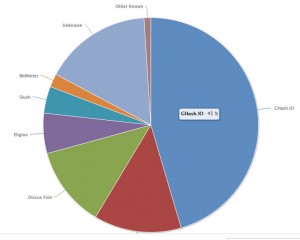Today, one of the largest pools in the bitcoin network, GHash.io, climbed past 45% of the total network hash power. GHash.io is now a mere 6% away from having the ability to implement a 51% attack. And that has many people feeling very, very nervous.
This isn’t the first time GHash.io has edged close to 51%. In January, the pool reached around 42% of the total hashrate, prompting owners CEX.io to issue a statement claiming it would take “all necessary precautions” to prevent a 51% scenario. The pool’s actions did see a sharp reduction in pool membership, with many miners leaving the pool voluntarily to keep the overall network stable.
Barring an openly malicious intent, there is virtually no incentive for GHash.io or any other pool to actually reach 51%. Such a move would virtually guarantee a panic sell off, and threaten the stability of the bitcoin network itself to the point that prices would plummet. That said, miner complacency could easily result in a 51% scenario. In late May, the Litecoin community saw prices nosedive as the Coinotron pool approached 51% of the network hashing power, even though the pool operator took several actions to convince miners to point their miners elsewhere.
According to a 2012 blog post by Bitcoin Core developer Gavin Andresen, “Not To Be Used Except In Case of Emergency” plans exist for reacting to a malicious 51% scenario, although the use of such a plan would result in a hard fork of the Bitcoin Core code.
It’s worth noting that other hashrate-tracking systems are still reporting GHash.io as having a less threatening 36.2% of the total hashrate.














